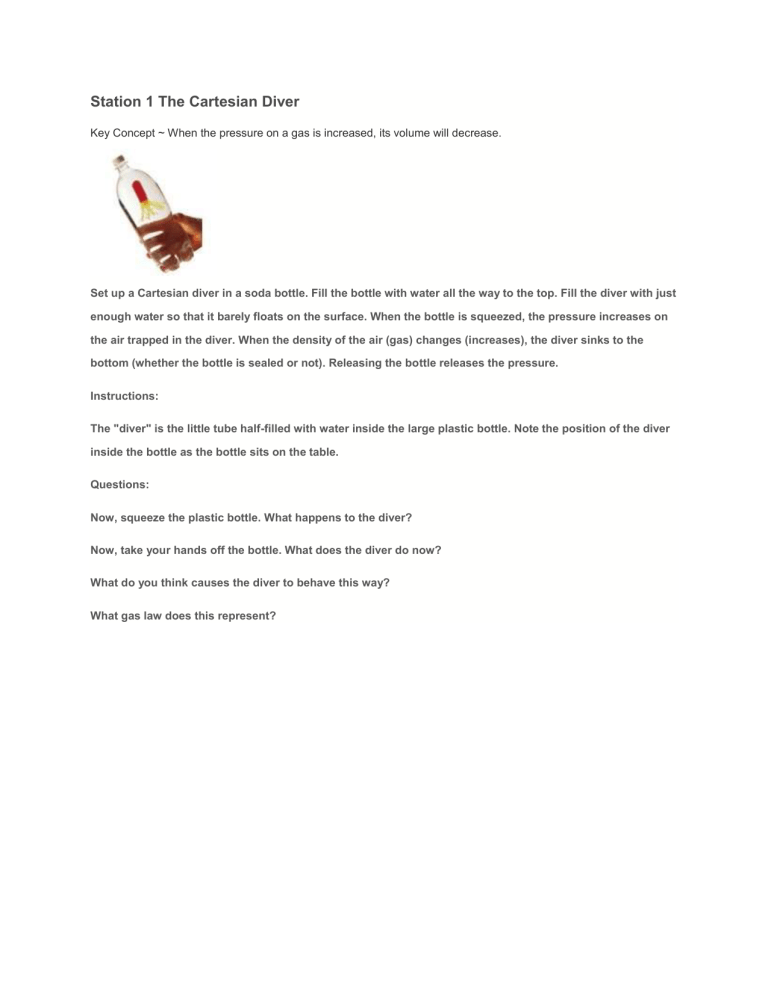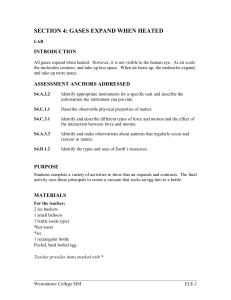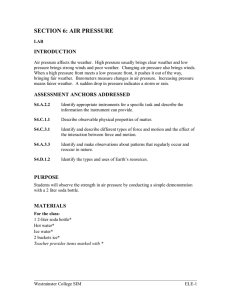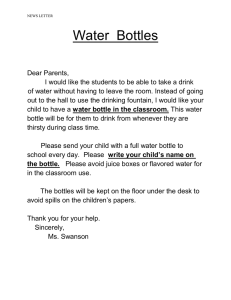7 Station Gas Laws Lab-instructions
advertisement

Station 1 The Cartesian Diver Key Concept ~ When the pressure on a gas is increased, its volume will decrease. Set up a Cartesian diver in a soda bottle. Fill the bottle with water all the way to the top. Fill the diver with just enough water so that it barely floats on the surface. When the bottle is squeezed, the pressure increases on the air trapped in the diver. When the density of the air (gas) changes (increases), the diver sinks to the bottom (whether the bottle is sealed or not). Releasing the bottle releases the pressure. Instructions: The "diver" is the little tube half-filled with water inside the large plastic bottle. Note the position of the diver inside the bottle as the bottle sits on the table. Questions: Now, squeeze the plastic bottle. What happens to the diver? Now, take your hands off the bottle. What does the diver do now? What do you think causes the diver to behave this way? What gas law does this represent? Station 2 Microwave Popcorn Key Concept ~ When the temperature of a gas is increased, its volume will increase. Students will be micro waving small amounts of popcorn in a clear bowl. Popcorn pops when the moisture inside boils and expands, bursting the kernel open. Instructions: Place about two tablespoons of popcorn in the clear plastic bowl. Put the top on the bowl and place in the microwave. Close the microwave door and turn the microwave on high. Watch as closely as you can as the popcorn kernels begin to pop, but of course DO NOT OPEN THE DOOR! As soon as the vigorous popping stops, turn off the microwave. Questions: Describe what you see (yeah, I know, but try). What do you think makes the popcorn pop? What gas law does this represent? Yes, you can eat it when we are finished with the labs. Station 3 Balloon and the Flask (or Hot Air Ballooning) Key Concept ~ When the temperature of a gas is increased, its volume will increase. Place 10 mLs. or so of water in an Erlenmeyer flask. Stretch an un-inflated balloon over the mouth of the flask (250 mL. flask). Place the flask next to a hot plate with a thermal (oven) glove so that students can move the flask easily from the hot plate to the ice water. Students will see how an increase in temperature can cause in increase in the volume of a gas. Instructions: Place flask on hot plate and let water boil. Questions: What happens to the balloon? Why? Now, put the flask in a beaker of ice and let it cool. Now what does the balloon do? Why? What law does this represent? Station 4 The Invisible Giant 1. You will need a hot plate, an empty aluminum soda can, a pair of beaker tongs, a large glass dish, and some ice. 2. Add a little bit of water to the empty soda can. Place the soda can on the hot plate and turn on the hot plate. 3. While the water in the can is heating up, fill the dish about ¾ full of ice water. 4. When the water in the can has reached a boil, quickly use the beaker tongs to move it from the hot plate and place it mouth down into the ice water. 5. Throw the can away. Pour the ice water down the sink. Make sure the hot plate is unplugged. What happened to the can once you placed it in the ice bath? Why do you think this happened? What gas law does this represent? Station 5 This Sucks! I'm under so much pressure! (Impossible...Science CAN'T suck!) Instructions: Fill a Styrofoam cup brim full (overflowing) and place an index cards securely on top. Make sure there is good contact between the card and lip of cup. Now, gently turn the cup sideways. What happens to the water? Now, gently turn the cup upside down and carefully let go of the card. What happens to the water now? How is this possible? What gas law is represented? Station 6 Super Duster & Office Buster Key Concept ~ When the volume of a gas increases, its temperature will decrease. Obtain a can of compressed "air," such as those used to clean electronic equipment. As you depress the nozzle, the gas inside (typically an HFC) responds to the reduced pressure by "boiling" or rapidly turning into a gas. This is an endothermic process so the can gets extremely cold (can even cause frost-bite if you hold it too long.) You can relate this to the phenomenon of water boiling at lower temperatures at high altitudes due to the lower pressure. (Lots of campers know this very well.) Instructions: Wrap your hand around one of the duster cans. Make sure your palm is in complete contact with the can. Now, depress the nozzle. Questions: How does the can feel when you wrap your little digits around it? Why? Shake the can. What do you notice? Try to explain what happens when you depress the nozzle. What gas law is represented here? Station 7 Pop Your Top and Watch it ExpandBaking Soda Vinegar Bottle and cap Place 10mL of vinegar in the bottle Place 10gm of baking soda in the bottle Quickly place the top on the bottle Observe 1. What happened through the process? Step by step 2. What Gas Law is represented here?



